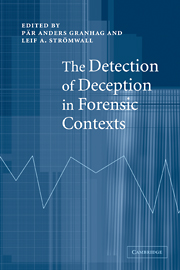Book contents
- Frontmatter
- Contents
- List of figures
- List of tables
- List of contributors
- Part 1 Introduction
- Part 2 Lie-detection techniques
- 2 Discerning lies from truths: behavioural cues to deception and the indirect pathway of intuition
- 3 Statement Validity Analysis and the ‘detection of the truth’
- 4 Reality monitoring and detection of deception
- 5 The psychophysiological detection of deception
- Part 3 Special issues facing a lie-catcher
- Part 4 Enhancing lie-detection accuracy
- Part 5 Conclusions
- Index
- References
2 - Discerning lies from truths: behavioural cues to deception and the indirect pathway of intuition
Published online by Cambridge University Press: 22 September 2009
- Frontmatter
- Contents
- List of figures
- List of tables
- List of contributors
- Part 1 Introduction
- Part 2 Lie-detection techniques
- 2 Discerning lies from truths: behavioural cues to deception and the indirect pathway of intuition
- 3 Statement Validity Analysis and the ‘detection of the truth’
- 4 Reality monitoring and detection of deception
- 5 The psychophysiological detection of deception
- Part 3 Special issues facing a lie-catcher
- Part 4 Enhancing lie-detection accuracy
- Part 5 Conclusions
- Index
- References
Summary
Can you tell whether suspects are lying based on what they say, how they say it, how they sound when they say it, or how they look? Can you do so even without any special equipment, such as a polygraph to monitor physiological responses (Honts, this volume) or a camera to record interviews, which can then be studied in microscopic detail (O'Sullivan and Ekman, this volume)? These are the questions we will address in this chapter.
Reading this chapter will not give anyone grounds for feeling smug about his or her deception detection prowess in forensic contexts (nor in any other contexts, for that matter). The study of verbal and non-verbal behavioural cues to deception is an inexact science, and probably always will be. We will offer hints, based on the current state of the science, about the kinds of behaviours that are more or less likely to intimate that a suspect may be lying. Our suggestions may be of some value in cases in which more definitive evidence, such as DNA, is not available or has not yet been uncovered. We hope our review will also prove useful in demonstrating why sweeping statements about perfect cues to deception are deserving of deep scepticism.
There are two fundamental questions in the study of verbal and nonverbal cues to deception. First, are there any such cues? That is, are there any behaviours that indicate whether a person may be lying?
- Type
- Chapter
- Information
- The Detection of Deception in Forensic Contexts , pp. 15 - 40Publisher: Cambridge University PressPrint publication year: 2004
References
- 62
- Cited by



